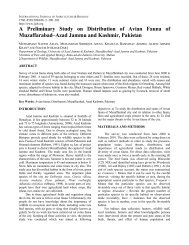Notes on Typhlops diardi - the Wildlife of Pakistan Website
Notes on Typhlops diardi - the Wildlife of Pakistan Website
Notes on Typhlops diardi - the Wildlife of Pakistan Website
You also want an ePaper? Increase the reach of your titles
YUMPU automatically turns print PDFs into web optimized ePapers that Google loves.
20<br />
Let me know ehat you think.<br />
I believe <strong>the</strong> o<strong>the</strong>r subspecies <strong>of</strong> T. <strong>diardi</strong> (T.d.muelleri from<br />
Indo-Australia) is now recognised as a valid full species.<br />
I welcome your comments.<br />
Regards,<br />
Mark<br />
I will copy <strong>the</strong> videos to you next week if I have a chance.<br />
<strong>Typhlops</strong> <strong>diardi</strong>i Diard's blindsnake<br />
11/3/92 Bardia Base Camp, Geruwa River, w. RBNP.<br />
14/3/92 (x2) Bardia Base Camp, Geruwa River, w. RBNP.<br />
Three blindsnakes were located under rotten logs around <strong>the</strong><br />
expediti<strong>on</strong> base camp. All three specimens agreed with <strong>Typhlops</strong><br />
<strong>diardi</strong>i <strong>diardi</strong>i as described in Smith (1943 pp.51-52) with 24<br />
l<strong>on</strong>gitudinal scale rows at midbody, a dark brown dorsum and<br />
slightly lighter venter but without str<strong>on</strong>g demarcati<strong>on</strong>.<br />
T. <strong>diardi</strong>i is not generally c<strong>on</strong>sidered an Indian subc<strong>on</strong>tinent<br />
taxa (see discussi<strong>on</strong>.)<br />
Discussi<strong>on</strong><br />
Royal Bardia Nati<strong>on</strong>al Park lies <strong>on</strong> <strong>the</strong> c<strong>on</strong>tact z<strong>on</strong>e between<br />
Smith's (1933) Gangetic Plains (which he c<strong>on</strong>sidered<br />
faunistically part <strong>of</strong> India) and his Eastern Himalayan regi<strong>on</strong><br />
(which he c<strong>on</strong>sidered faunistically Indo-Chinese).<br />
The terai is low m<strong>on</strong>tane forest typical <strong>of</strong> <strong>the</strong> Himalayan regi<strong>on</strong><br />
whereas <strong>the</strong> phantas grassland is more indicative <strong>of</strong> neighbouring<br />
Uttar Pradesh in India. However, <strong>the</strong> denticulate delta plain<br />
formed by <strong>the</strong> Karnali River, as it exits <strong>the</strong> narrow Chisapani<br />
Gorge and spreads out over <strong>the</strong> lowlands, blurs <strong>the</strong> boundaries<br />
between Himalayan terai and Gangetic phantas. Evenso,<br />
most <strong>of</strong> <strong>the</strong> survey fieldwork was carried out in <strong>the</strong> sal forest<br />
<strong>of</strong> <strong>the</strong> terai and could, <strong>the</strong>refore, be c<strong>on</strong>sidered just inside<br />
Smith's Eastern Himalayan regi<strong>on</strong>. Das (1996) did not c<strong>on</strong>sider<br />
<strong>the</strong> grassland plains and m<strong>on</strong>tane forest habitats different<br />
physiographic z<strong>on</strong>es, preferring to term <strong>the</strong> entire Uttar<br />
Pradesh, Nepal, Bhutan, Sikkim and nor<strong>the</strong>rn West Bengal z<strong>on</strong>e<br />
as 'Himalayas'.<br />
Most <strong>of</strong> <strong>the</strong> species recorded during here are well documented<br />
Indian sub-c<strong>on</strong>tinent reptiles occurring widely from sou<strong>the</strong>rn<br />
India (and Sri Lanka) to Nepal but three <strong>of</strong> <strong>the</strong> snake taxa are<br />
<strong>of</strong> particular zoogeographical interest since <strong>the</strong>y are not<br />
species generally associated with <strong>the</strong> Indian subc<strong>on</strong>tinent<br />
herpet<strong>of</strong>auna. <strong>Typhlops</strong> <strong>diardi</strong>i<br />
The range <strong>of</strong> T. <strong>diardi</strong>i is recorded as nor<strong>the</strong>ast India (Assam),<br />
Bangladesh, Burma, China, Vietnam, Laos, Cambodia, Thailand,<br />
peninsular Malaysia and Ind<strong>on</strong>esia (Sumatra and Borneo, with a<br />
doubtful record from Irian Jaya) (Smith 1943, McDowell 1974, Cox<br />
1991). Two subspecies are recognised by some authors: T. d.<br />
<strong>diardi</strong>i occurring north <strong>of</strong> latitude 16=83 in Indo-China<br />
20




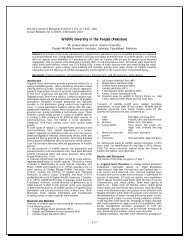
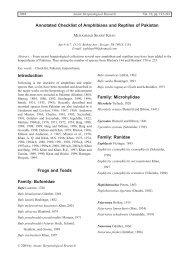



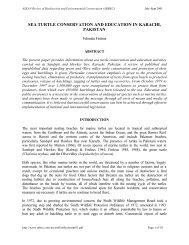
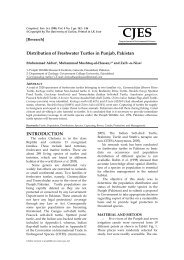
![Dureji (Ovis orientalis [vignei] blanfordi) - Wildlife of Pakistan](https://img.yumpu.com/11814520/1/190x245/dureji-ovis-orientalis-vignei-blanfordi-wildlife-of-pakistan.jpg?quality=85)
